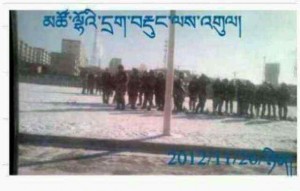
A former political prisoner died at the age of 84 after years of house arrest and poor health caused by injuries sustained during more than two years of detention in Chabcha (Ch: Gonghe) County, Tsolho (Ch: Hainan) Tibetan Autonomous Prefecture, Qinghai Province, in Tibet’s Amdo province.
Gyaye Phuntsok died last Monday at about 1 am local time after prolonged illness at his home in Gyaye Village in Chabcha. He was 68 when he was first detained in August 1998 by a group of Qinghai state security officers and armed police. In a subsequent raid at his home, the police seized a portrait of the Dalai Lama and a Tibetan history book. He was later charged with engaging in separatist activity and held in detention for two years. In 2000, when he was released, his health had deteriorated to the point that he was later confined to his bed for years until his death. One of the conditions for his release was that he will be put under house arrest for the next 10 years. In 2012, his health deteroriated further when he met with an accident. Efforts to seek treatments failed and his health did not improve.

